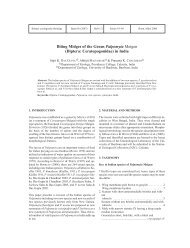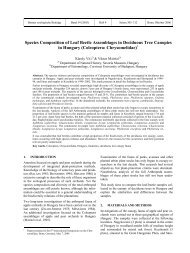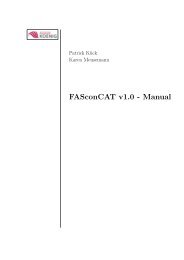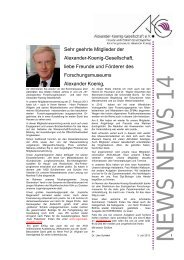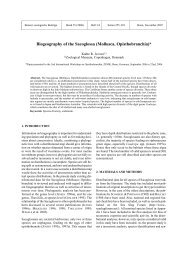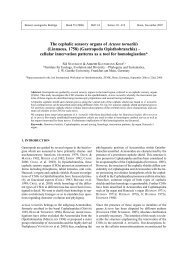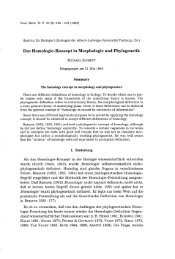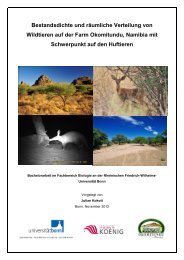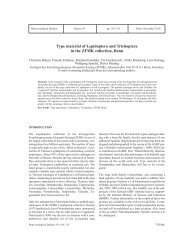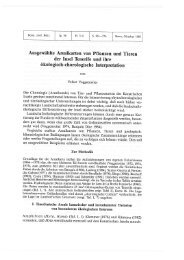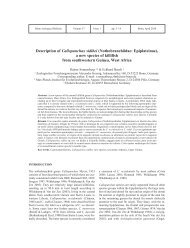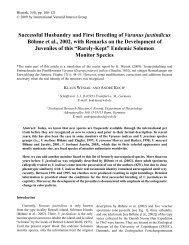Islands Between the Realms: A Revised Checklist of the ...
Islands Between the Realms: A Revised Checklist of the ...
Islands Between the Realms: A Revised Checklist of the ...
Create successful ePaper yourself
Turn your PDF publications into a flip-book with our unique Google optimized e-Paper software.
Bonner zoologische Beiträge 56 (2007)<br />
121<br />
Taxonomy: DE ROOIJ (1915), DE JONG (1928) and BRAN-<br />
DENBURG (1983) referred <strong>the</strong> Talaud population to <strong>the</strong> Pacific<br />
monitor lizard, V. indicus. However, due to particular<br />
characteristics in color pattern and pholidosis toge<strong>the</strong>r<br />
with molecular genetic evidence (ZIEGLER et al. 2007),<br />
<strong>the</strong> Talaud monitor lizards represent a new member <strong>of</strong> <strong>the</strong><br />
V. indicus species group (KOCH et al. subm.).<br />
SERPENTES<br />
Typhlopidae<br />
Typhlops sp.<br />
Material examined: MZB Serp. 3227 (AK045).<br />
Distribution: First record <strong>of</strong> a blind snake species for <strong>the</strong><br />
Talaud <strong>Islands</strong>.<br />
Ecology: Two specimens were found under a coconut<br />
shell in a plantation near <strong>the</strong> coast <strong>of</strong> which one specimen<br />
was preserved.<br />
Morphology & Taxonomy: ToL 130 mm; body width 2.2<br />
mm; 255 ventrals, 13 or 14 subcaudals. The voucher specimen<br />
resembles <strong>the</strong> drawing <strong>of</strong> <strong>the</strong> holotype <strong>of</strong> T.<br />
hedraeus (CAS-SU 12346) depicted by IN DEN BOSCH &<br />
INEICH (1994) in having <strong>the</strong> eye restricted to <strong>the</strong> ocular<br />
scale not reaching <strong>the</strong> suture to <strong>the</strong> preocular; a subocular,<br />
in contrast to T. ater from Sulawesi, <strong>the</strong> Moluccas and<br />
New Guinea, is absent. However, <strong>the</strong> voucher differs from<br />
T. hedraeus in having two instead <strong>of</strong> one preocular and<br />
<strong>the</strong> latter is not smaller than <strong>the</strong> ocular. The upper jaw is<br />
not visible laterally. T. hedraeus is found on several Philippine<br />
<strong>Islands</strong> including Mindanao, Luzon and Negros, <strong>the</strong><br />
type locality. Due to differences in morphology, <strong>the</strong> Talaud<br />
population may represent a distinct species.<br />
Distribution: Beside Talaud, C. paulsoni tasmai inhabits<br />
Halmahera and surrounding islands as well as <strong>the</strong> tip<br />
<strong>of</strong> North Sulawesi (SMITH et al. 2001; DE LANG & VOGEL<br />
2005). Consequently, <strong>the</strong> Talaud <strong>Islands</strong> are <strong>the</strong> most<br />
north-western population <strong>of</strong> this subspecies which is separated<br />
by about 800 km from <strong>the</strong> remaining subspecies <strong>of</strong><br />
C. paulsoni on New Guinea and <strong>the</strong> Solomon <strong>Islands</strong><br />
(SMITH et al. 2001). In contrast, C. carinata is found on<br />
Sangihe Island enclosed between C. paulsoni on <strong>the</strong> Talaud<br />
<strong>Islands</strong> in <strong>the</strong> north and <strong>the</strong> nor<strong>the</strong>rn peninsula <strong>of</strong> Sulawesi<br />
in <strong>the</strong> south. However, historical records <strong>of</strong> Candoia<br />
from <strong>the</strong> “Minahassa” peninsula, North Sulawesi, by<br />
MEYER (1887) and independently by BOETTGER (1898) as<br />
adopted by BOULENGER (1897), DE ROOIJ (1917), STERN-<br />
FELD (1920), MCDOWELL (1979), IN DEN BOSCH (1985),<br />
ISKANDAR & NIO (1996), SMITH et al. (2001), and DE LANG<br />
& VOGEL (2005) may be incorrect as was repeatedly assumed<br />
for some o<strong>the</strong>rs <strong>of</strong> MEYER’s vertebrate collections<br />
(see HICKSON [1889: 158] and STRESEMANN [1939: 305]<br />
for birds and FEILER [1990] for mammals, respectively).<br />
Confusion <strong>of</strong> locality data may have easily occurred since<br />
MEYER did not exclusively undertake his collection on <strong>the</strong><br />
Minahassa peninsula <strong>of</strong> Sulawesi, but also purchased<br />
many voucher specimens from Charles W. CURSHAM, a<br />
trader in Manado, who in turn sent out native hunters<br />
(MEYER & WIGLESWORTH 1898). Intense fieldwork in<br />
North Sulawesi in recent years has revealed no voucher<br />
specimens confirming <strong>the</strong> historical records (J. MCGUIRE<br />
pers. comm., KOCH & ARIDA unpubl. data). It is, <strong>the</strong>refore,<br />
reasonable to suggest that <strong>the</strong> “Minahassa” specimen (not<br />
present in <strong>the</strong> MTD collection and most probably lost dur-<br />
Boidae<br />
Candoia paulsoni tasmai Smith & Tepedelen in<br />
Smith et al. 2001 (Fig. 16)<br />
Material examined: MZB Serp. 2949, Niampak, Karakelong<br />
Island, 21 March 1999; MZB Serp. 2950, Essang,<br />
Karakelong Island, coll. WCS 5 April 1999.<br />
Additional material: MCZ 45767 (paratype), Karakelong,<br />
coll. FAIRCHILD Garden Expedition 1940; ZMA 16937,<br />
Gunung Doeata (= Mt. Duata), Karakelong, coll. H. J. LAM<br />
1926; ZMA 16943 (4 spec.), Liroeng (= Lirung), Salibabu,<br />
coll. M. WEBER 1899<br />
Fig. 16. Candoia paulsoni tasmai (MZB Serp. 2950) from Karakelong<br />
Island. Photo by André Koch.




